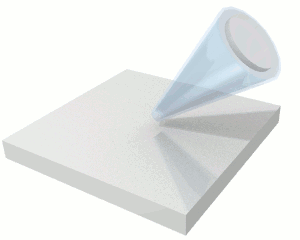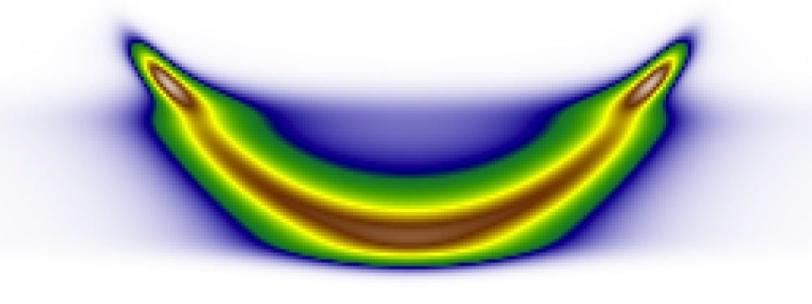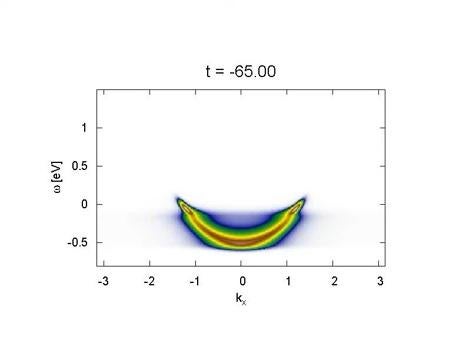SIMES Simulations Track Energized Electrons to Understand Complex Materials
Jolting complex materials with bursts of energy from rapid-fire lasers can help scientists learn why some of these materials exhibit useful properties such as high-temperature superconductivity.
By Mike Ross
Jolting complex materials with bursts of energy from rapid-fire lasers can help scientists learn why some of these materials exhibit useful properties such as high-temperature superconductivity, a team led by SLAC and Stanford researchers has reported.
The group used supercomputers to simulate how an initial laser pulse energizes electrons in the material. The electrons then trigger atomic vibrations, called phonons, that dissipate the excess energy. A split second later, a second laser pulse takes stop-action images of the electrons. Details of the electron-phonon interactions reveal important qualities that underlie the material's properties.
"We are creating a fundamentally new way of understanding and engineering complex materials based on how their electrons react when excited far from equilibrium," said the team's leader, Tom Devereaux, director of the Stanford Institute for Materials and Energy Sciences (SIMES), which is run jointly with SLAC. "Understanding – and ultimately controlling – the details of such electron behavior will help us design new materials relevant to fundamental energy science and applications."
The team published its report in Physical Review X.
Non-equilibrium science
Devereaux said this research is part of an emerging quest to better understand how the world works by examining more realistic situations, despite their daunting complexity.
Most science today is based on insights gained from theories and experiments involving systems that are in balance, or nearly in balance, with their surroundings, both thermally and mechanically, Devereaux said. "But most of the world around us is far more complex, and is also far from equilibrium," he said. "Virtually everything is continually responding to external stimuli or energy." He said non-equilibrium systems include complex weather systems, which respond to air, moisture and energy flows; photosynthesis, the process by which plants convert sunlight and carbon dioxide into glucose and oxygen; and even the volatile evolution of financial markets as they react to economic events.

"Current equilibrium-based theories apply to only a very small subset of the phenomena we observe around us," Devereaux said. "Even our vocabulary to describe non-equilibrium phenomena is desperately lacking."
The SLAC-led research relates to two of the DOE Office of Science's five Grand Challenges for Science and the Imagination, which aim to develop effective new scientific capabilities for studying non-equilibrium phenomena: Grand Challenge #3: How do remarkable properties of matter emerge from complex correlations of the atomic or electronic constituents, and how can we control these properties? And Grand Challenge #5: How do we characterize and control matter away – especially very far away – from equilibrium?
Movies of a Virtual Experiment
In the study, the team simulated a typical “pump-probe” experiment, in which a near-infrared laser pulse hits a sample and triggers changes that are imaged a few quadrillionths of a second later with a different, ultraviolet laser pulse. This study was aimed at learning how the excited electrons relaxed back into a state of equilibrium by interacting with and transferring their energy to the phonons. Varying the time delay between the first and second laser pulses allowed researchers to create short, stop-action movies of the electrons' behavior.
These simulations used a total of 1 million central-processing-unit hours at the DOE's National Energy Research Scientific Computing Center at Lawrence Berkeley National Laboratory.
More Precise Calculations
"Our calculations found that the higher-energy electrons lose their energy faster than the lower-energy ones," said Michael Sentef, a SIMES postdoctoral researcher and the report's lead author. This information allows scientists to get a more precise value for the material's equilibrium self-energy (ESE), a factor that’s essential for understanding electron-phonon interactions like those thought to enable high-temperature superconductivity.
Previous techniques for determining ESE introduced errors and resulted in widely varying values for the same material, Sentef said. “Our approach shows experimentalists a direct way to get ESE without any complicating assumptions."
The team next plans to simulate how a superconductor first loses and then recovers its superconductivity when it is hit by light pulses and to study how light-matter interactions can create new states of matter that lack any known equilibrium counterparts.
In addition to SLAC, Stanford and Berkeley Lab, the research team included a scientist from Georgetown University in Washington, D.C. Funding for this research came from the DOE’s Office of Basic Energy Sciences. The National Energy Research Scientific Computing Center is funded by the DOE Office of Science.
Citation: M. Sentef et al., Physical Review X, 26 December 2013 (10.1103/PhysRevX.3.041033).
SLAC is a multi-program laboratory exploring frontier questions in photon science, astrophysics, particle physics and accelerator research. Located in Menlo Park, Calif., SLAC is operated by Stanford University for the U.S. Department of Energy's Office of Science. To learn more, please visit www.slac.stanford.edu.
The Stanford Institute for Materials and Energy Sciences (SIMES) is a joint institute of SLAC National Accelerator Laboratory and Stanford University. SIMES studies the nature, properties and synthesis of complex and novel materials in the effort to create clean, renewable energy technologies. For more information, please visit simes.slac.stanford.edu.
DOE’s Office of Science is the single largest supporter of basic research in the physical sciences in the United States, and is working to address some of the most pressing challenges of our time. For more information, please visit science.energy.gov.


arpes height weak
This short simulation video shows the energy (vertical) and momentum (horizontal: left & right from the middle) of electrons rising and falling as they absorb and disperse energy from a pulse of near-infrared light. This first of two animations shows the impact of a relatively weak pulse; the second video shows the effect of a pulse 10 times stronger.
Credit: Michael Sentef





